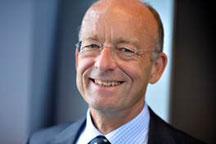SMEs need capital more than the banks
As a major player in the financial sector, ING aims to contribute to debate on the future. In this context, on 13 December the NRC published this contribution of ING Bank's chief risk officer, Wilfred Nagel.

Chief Risk Officer, Wilfred Nagel
It’s not politicians but scenarios that determine how much capital ING needs, says Wilfred Nagel
Politicians and professors are banging their drum: “don’t listen to the banks, raise their buffers”. The tension is rising and academics are falling over each other to express their views and opinions.
There is no mention of the fact that Dutch banks have significantly strengthened their buffers since 2008. But the key question is rarely, if ever, posed: how much capital does a bank need to prevent extreme losses being inflicted on savers or taxpayers? I would like to put forward ING’s response.
Traditionally, banks have set their capital, in line with the Basel banking rules, mainly by estimating the probability of default for each loan and the loss that could be expected. As the current crisis has clearly shown, this approach has a major weakness: it does not properly reflect concentration risks or substantial movements in market prices that could affect the value of collateral.
As a result, since 2008, banks have made much greater use of scenario analyses which look at what would happen in the event of sharp falls in asset prices, extreme unemployment and high default rates. These analyses not only include historical information but they also model potential new ‘disasters’. This makes it possible to determine far more accurately how much capital is required to absorb extreme unforeseen losses.
The information on ING’s capital position is drawn from our published figures. I will only look here at the overall buffer that protects our savers.
The defences have several layers: unforeseen losses are first charged against the operating result and then against the provisions and next the bank’s risk-bearing equity and loan capital is used. In ING’s case, based on the average results in the last few years, this covers some €60 billion, 10% of the total loans portfolio.
This figure is about twenty times greater than the largest loss that ING has ever suffered on its loans book. The government has to decide whether this is sufficient, but I think it is.
All the more so now that new ‘bail-in’ rules apply on top of this. These mean that, in an actual extreme disaster scenario, ordinary bond-holders would also be called on before any approach is made to the taxpayer. As a result of this, ING could absorb a further €50 billion of potential losses.
All in all, this means that the current risks for savers and taxpayers are, quite properly, incomparably smaller than in 2008.
This brings me to my final point: banks are accused of locking down the economy by saying no to businesses and investing mainly in government bonds because of capital shortfalls.
For ING this is simply not the case: our portfolio of government bonds is almost the same now as in 2008 and they are held mainly for liquidity purposes. Although our total lending to small and medium-sized businesses has shrunk, the fall is in line with that in GDP and, furthermore, it is not because we are refusing more loans.
The reduction is mainly because of write-downs as a result of defaults. The number of credit applications has also dropped by 50%; something which, unfortunately, is not unusual in difficult economic times. Consequently, this is not an argument for making banks draw further capital.
In short, we should not strengthen capital just because we can. If not, risk-bearing capital could be put to better use: small and medium-sized enterprises need it more than the banks at the moment.
Read also the article by Koos Timmermans in Het Financieele Dagblad of 13 December 2013.
